Mastering the North Star Metric: A Data-Driven Approach to Scaling
Get the latest updates about our blog posts.
Subscribe so you don’t miss out!
Scaling a business is both an art and a science. Many companies struggle to grow efficiently because they focus on the wrong metrics—vanity metrics like website traffic, social media followers, or even total revenue. But what if there was a single guiding metric that could align your entire team, drive strategic decisions, and ensure sustainable growth?Key Takeaways
- The North Star Metric (North Star Metric) is a single, guiding metric that reflects the core value your business provides to customers.
- Choosing the right North Star Metric aligns your entire organization, ensuring every team works toward a common growth goal.
- Top companies like Airbnb and Netflix have successfully scaled by optimizing their North Star Metric.
- The best North Star Metric is measurable, actionable, and directly correlated with long-term customer retention and revenue growth.
- Continuous tracking, experimentation, and optimization of your North Star Metric are crucial for sustainable business success.
Enter the North Star Metric (NSM)—the key indicator that directly reflects the value your company delivers to customers. Used by successful companies like Airbnb, Spotify, and Slack, the North Star Metric keeps organizations focused on long-term success rather than short-term gains.
In this blog, we’ll break down what the North Star Metric is, how to define it for your business, and how a data-driven approach can help scale your company efficiently.
What is a North Star Metric?
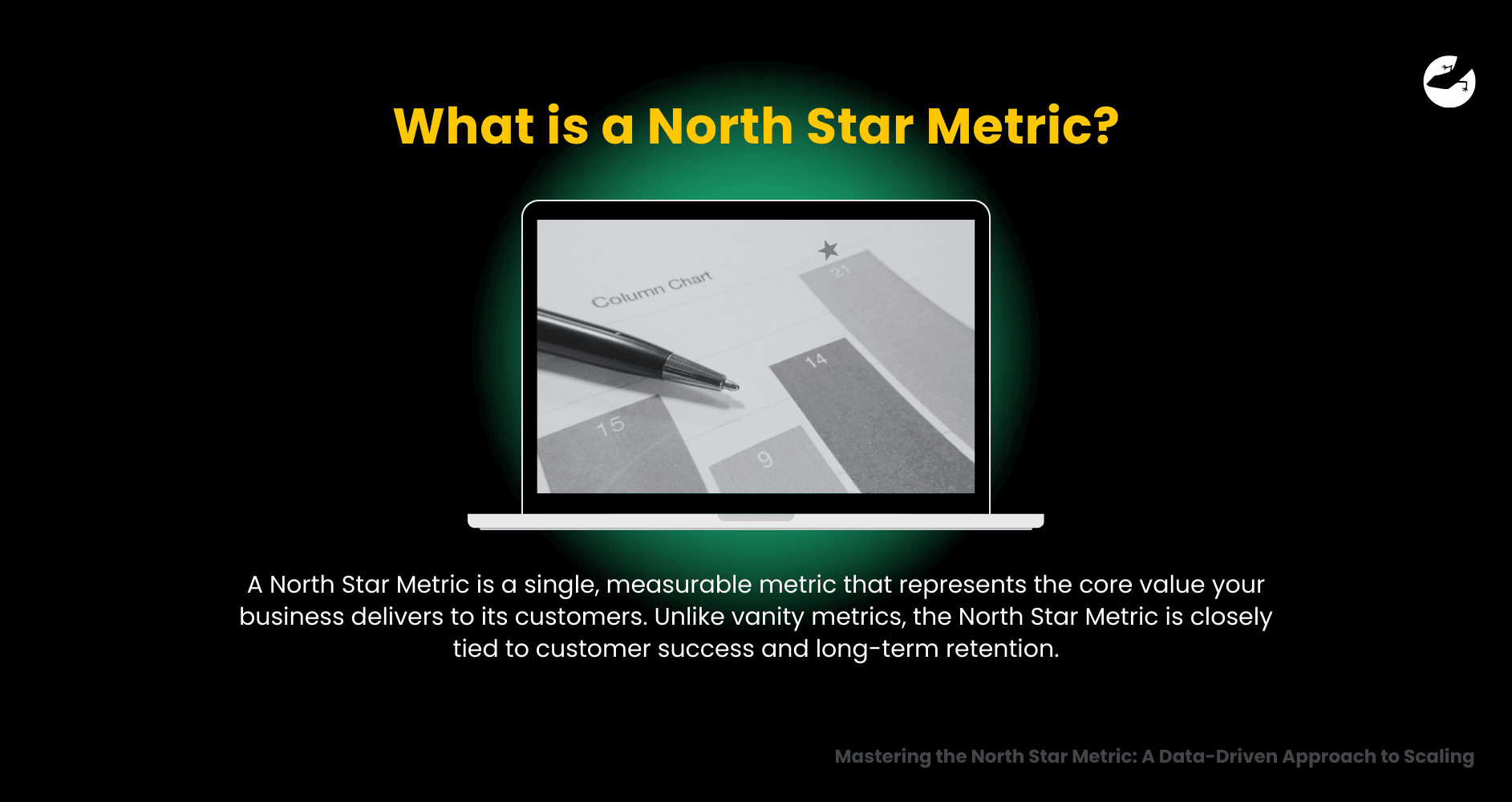
A North Star Metric, not to be confused with the One Metric That Matters, is a single, measurable metric that represents the core value your business delivers to its customers. Unlike vanity metrics, the North Star Metric is closely tied to customer success and long-term retention.
For example:
- Airbnb: Nights booked
- Spotify: Time spent listening
- Slack: Number of messages sent per user
- Facebook: Daily active users (DAUs)
By focusing on their North Star Metric, these companies ensure that every team—from marketing to product development—works towards a shared goal, ultimately driving sustainable growth.
Why is the North Star Metric Crucial for Scaling?
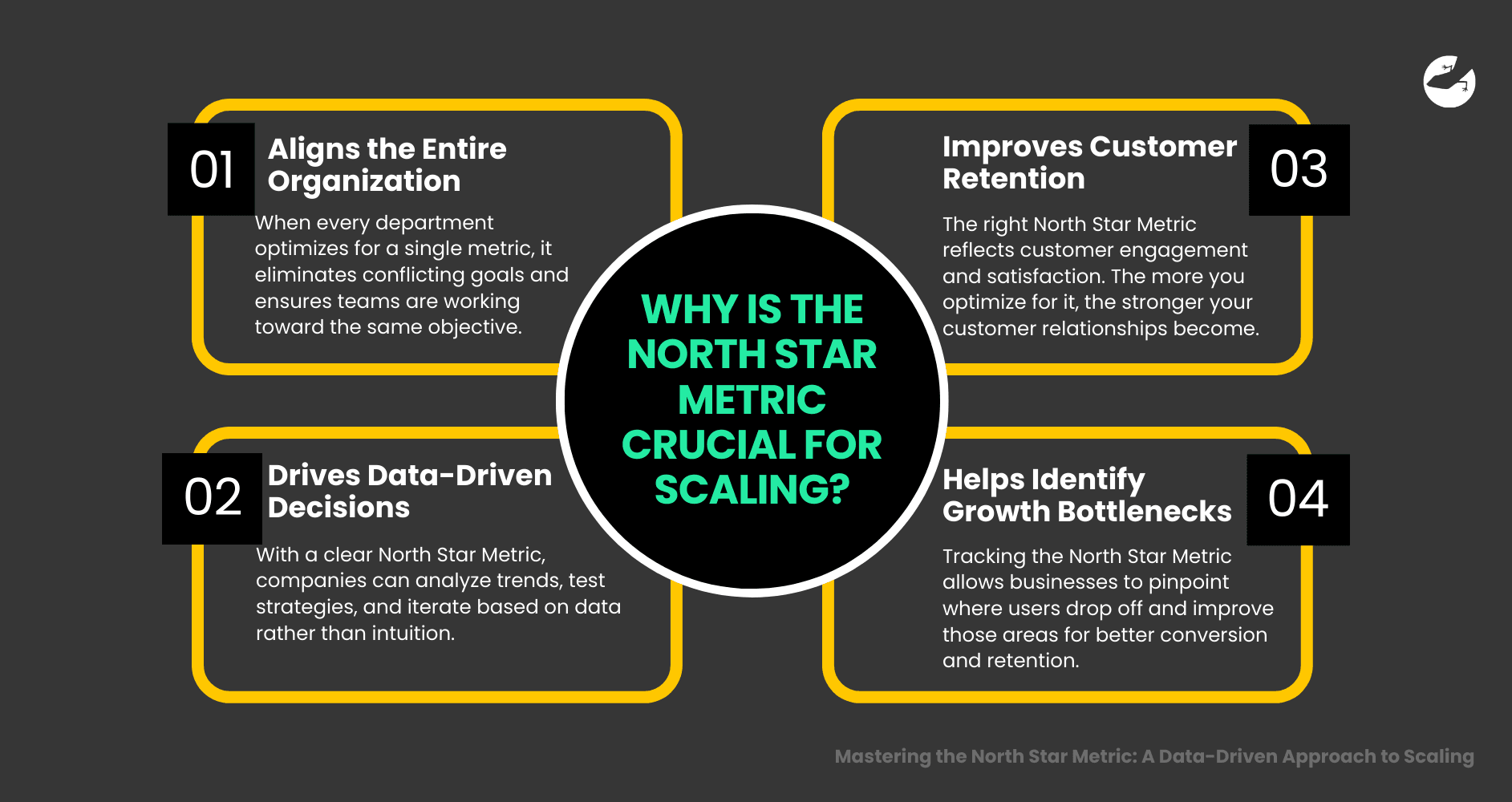
Choosing the right North Star Metric can transform the way your business grows. Here’s why:
1. Aligns the Entire Organization
When every department optimizes for a single metric, it eliminates conflicting goals and ensures teams are working toward the same objective.
2. Drives Data-Driven Decisions
With a clear North Star Metric, companies can analyze trends, test strategies, and iterate based on data rather than intuition.
3. Improves Customer Retention
The right North Star Metric reflects customer engagement and satisfaction. The more you optimize for it, the stronger your customer relationships become.
4. Helps Identify Growth Bottlenecks
Tracking the North Star Metric allows businesses to pinpoint where users drop off and improve those areas for better conversion and retention.
How to Define Your North Star Metric
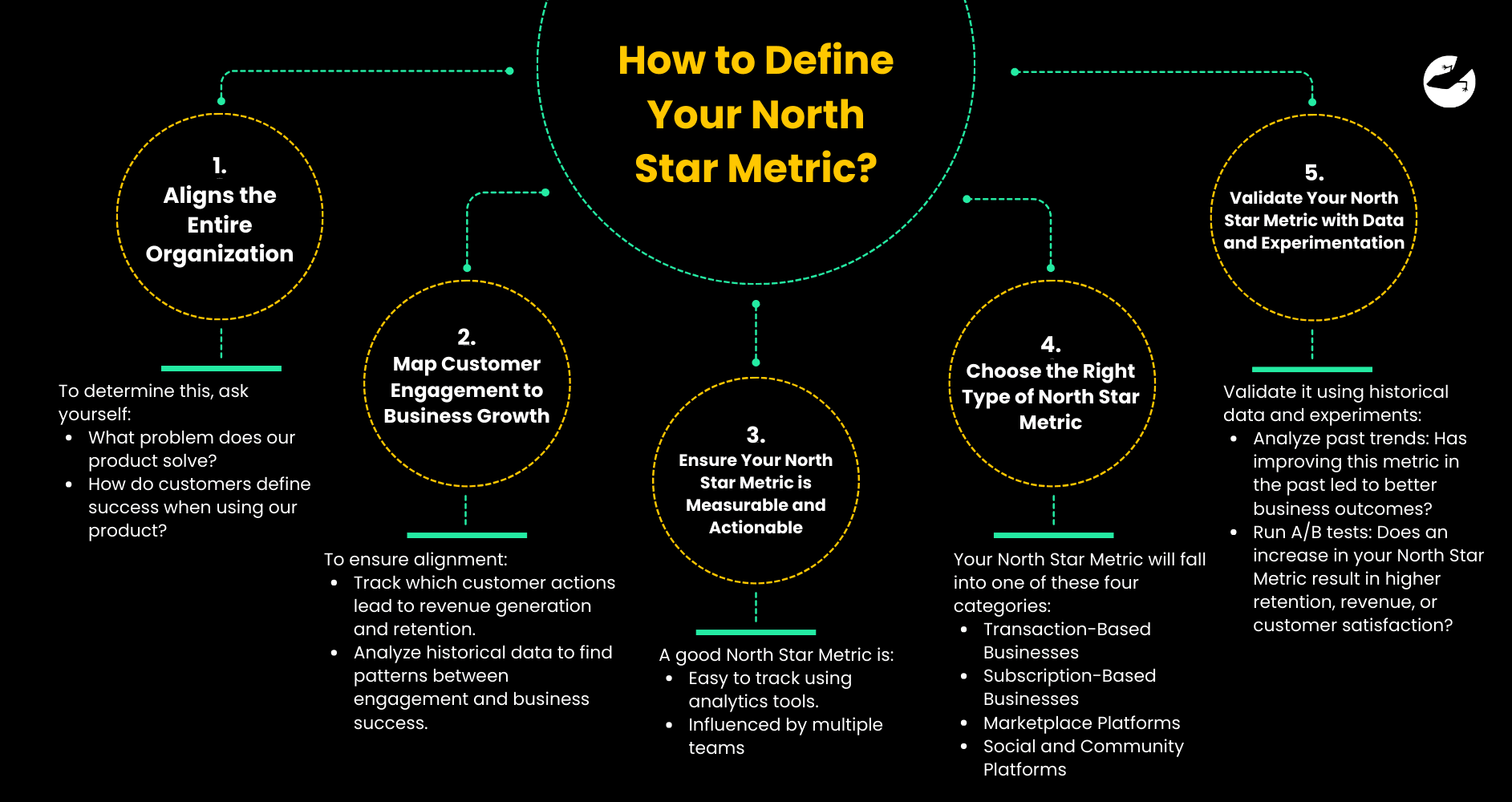
Choosing the right North Star Metric (NSM) is crucial for guiding your company's growth. It should reflect the core value your business delivers to customers while being measurable and actionable.
Follow these five essential steps to define a North Star Metric that aligns with your business model and drives sustainable growth.
1. Identify Your Core Value Proposition
Your North Star Metric should represent the main value your product or service provides to users.
To determine this, ask yourself:
- What user actions indicate that they are experiencing value?
Example:
- Uber: The core value is providing convenient transportation. North Star Metric: Rides completed per user.
Amazon: The core value is fast and seamless online shopping. North Star Metric: Number of purchases per customer.
Spotify: The core value is delivering personalized music experiences. North Star Metric: Total minutes listened per user.
Action Step: Conduct customer interviews or surveys to understand which aspects of your product provide the most value.
2. Map Customer Engagement to Business Growth
Your North Star Metric should directly correlate with revenue growth and long-term business success. If an increase in your North Star Metric doesn’t lead to a healthier business, you might be tracking the wrong metric.
To ensure alignment:
- Track which customer actions lead to revenue generation and retention.
- Analyze historical data to find patterns between engagement and business success.
- Identify the behaviors of your most valuable customers and optimize for those.
Example:
- Slack’s North Star Metric: “Messages sent per user.” More messages mean deeper engagement, leading to higher retention and customer lifetime value.
- Netflix’s North Star Metric: “Total watch time.” More viewing hours lead to higher user satisfaction and lower churn rates.
Action Step: Use tools like Google Analytics, Amplitude, or Mixpanel to analyze user behavior and identify which actions lead to higher retention and revenue.
3. Ensure Your North Star Metric is Measurable and Actionable
Your North Star Metric must be quantifiable and something your team can actively influence. A good North Star Metric is:
- Easy to track using analytics tools.
- Influenced by multiple teams across product, marketing, and customer success.
- A leading indicator of long-term growth (not just a lagging result like revenue).
Example:
- Bad North Star Metric for an e-commerce business: “Customer happiness” (Too vague and hard to measure).
- Good North Star Metric for an e-commerce business: “Average number of orders per active customer” (Quantifiable and directly impacts revenue).
Action Step: Set up a real-time dashboard to monitor your North Star Metric and ensure it remains actionable.
4. Choose the Right Type of North Star Metric
Depending on your business model, your North Star Metric will fall into one of these four categories:
Transaction-Based Businesses (E-commerce, marketplaces) Best North Star Metric: Number of transactions per user Example: Amazon → Orders placed per customer
Subscription-Based Businesses (SaaS, media streaming) Best North Star Metric: Engagement-related metric that predicts retention Example: Netflix → Total hours watched per subscriber
Marketplace Platforms (Ride-sharing, rental services) Best North Star Metric: Transactions or bookings completed Example: Airbnb → Number of nights booked
Social and Community Platforms (Social media, collaboration tools) Best North Star Metric: User engagement that increases platform value Example: Slack → Messages sent per user
Action Step: Select the North Star Metric category that best aligns with your business type and refine it based on customer behavior.
5. Validate Your North Star Metric with Data and Experimentation
Before fully committing to your North Star Metric, validate it using historical data and experiments:
- Analyze past trends: Has improving this metric in the past led to better business outcomes?
- Run A/B tests: Does an increase in your North Star Metric result in higher retention, revenue, or customer satisfaction?
- Monitor long-term impact: Does optimizing this metric create a network effect that accelerates growth?
Example: Dropbox originally focused on sign-ups but realized that "files uploaded" was a stronger predictor of long-term engagement. They adjusted their North Star Metric accordingly.
Action Step: Test multiple North Star Metric candidates and refine your choice based on real-world user behavior.
Want to find out how much it costs to build your dream app or web app?
Examples of North Star Metrics in Action
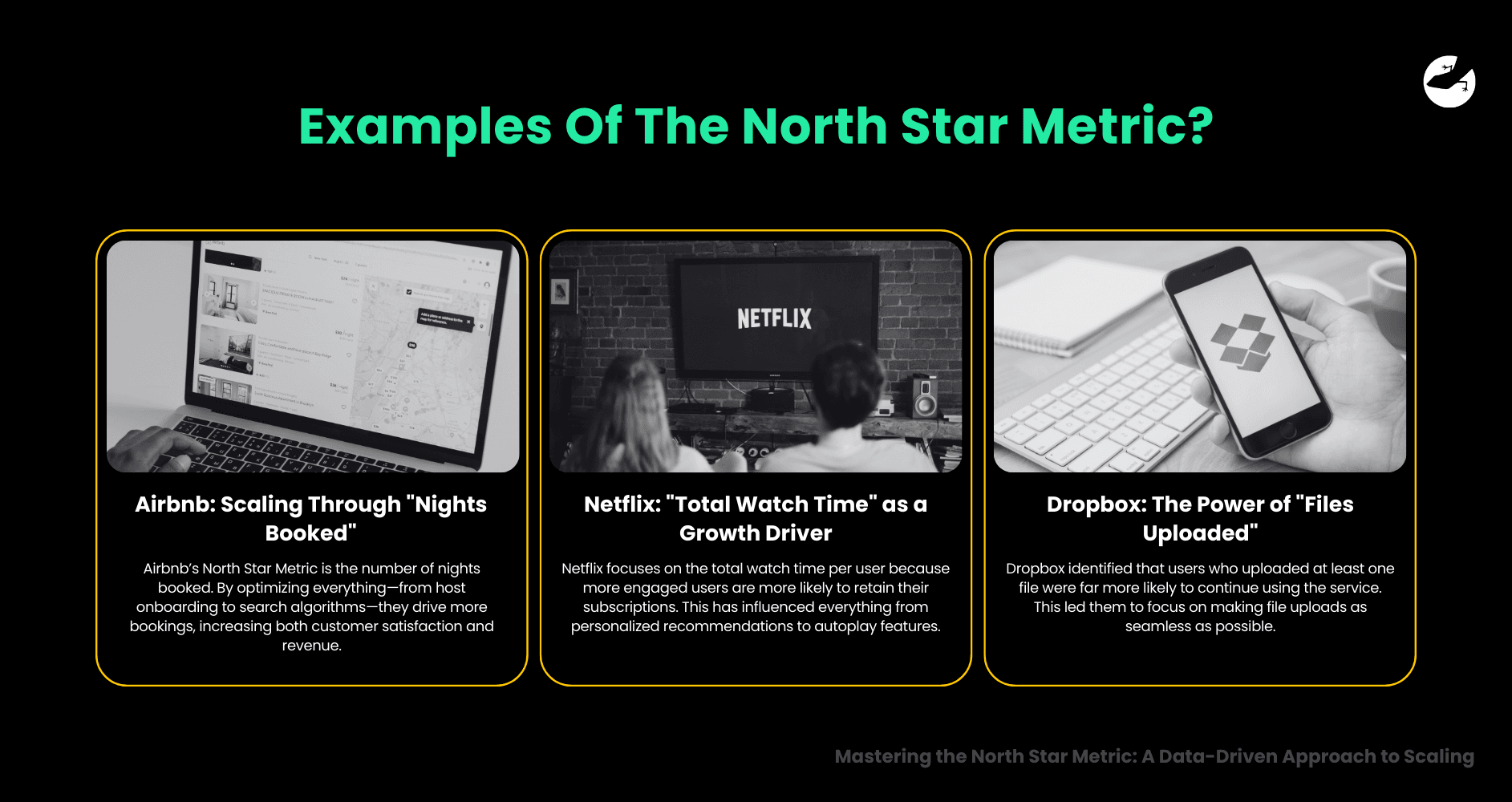
1. Airbnb: Scaling Through "Nights Booked"
Airbnb’s North Star Metric is the number of nights booked. By optimizing everything—from host onboarding to search algorithms—they drive more bookings, increasing both customer satisfaction and revenue.
2. Netflix: "Total Watch Time" as a Growth Driver
Netflix focuses on the total watch time per user because more engaged users are more likely to retain their subscriptions. This has influenced everything from personalized recommendations to autoplay features.
3. Dropbox: The Power of "Files Uploaded"
Dropbox identified that users who uploaded at least one file were far more likely to continue using the service. This led them to focus on making file uploads as seamless as possible.
How to Leverage the North Star Metric for Growth
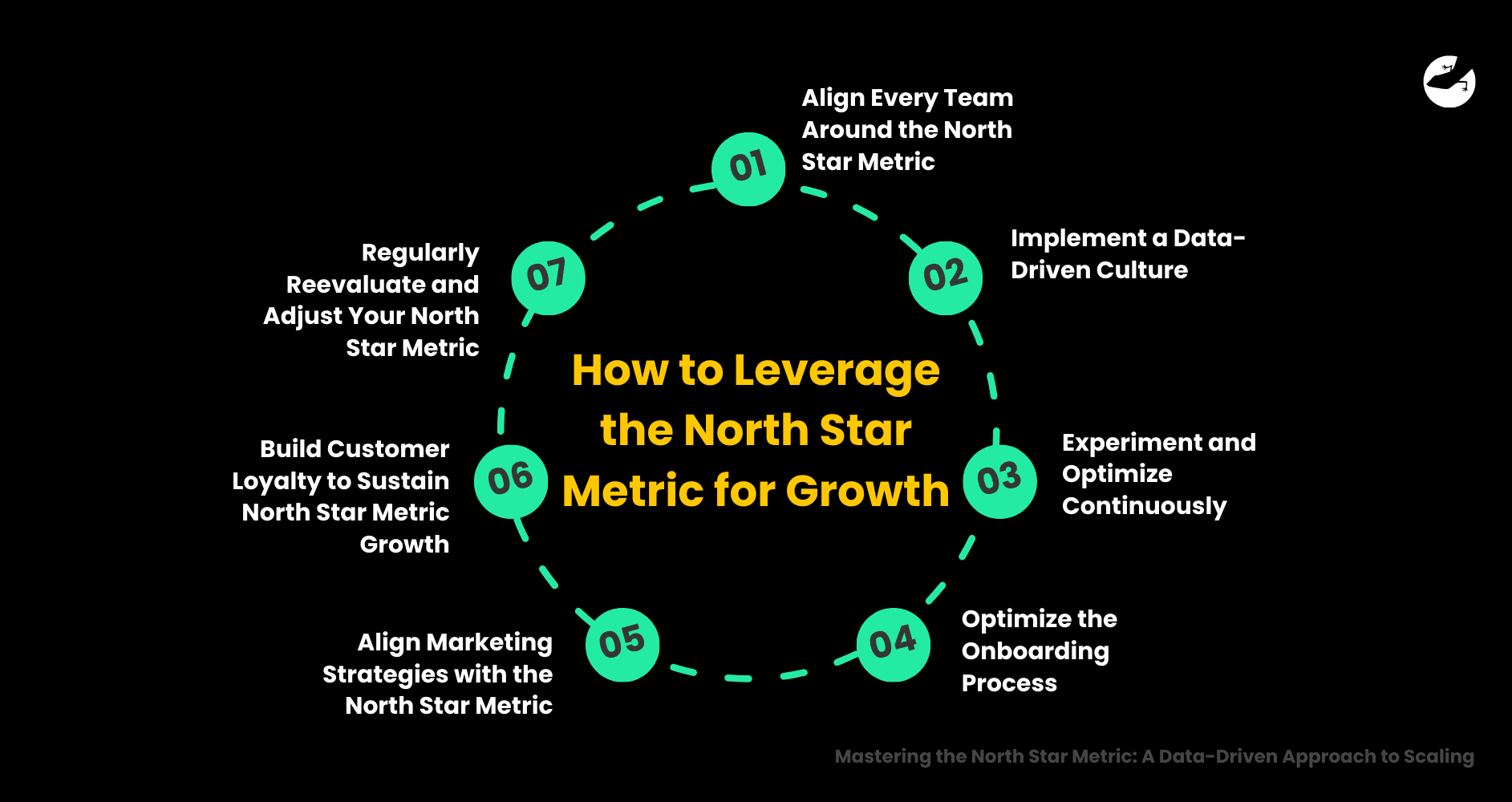
1. Align Every Team Around the North Star Metric
Your North Star Metric should serve as a company-wide guiding principle, ensuring all departments work toward the same goal. However, each team will contribute to the metric differently:
- Product Team: Optimizes features that enhance user engagement and retention.
- Marketing Team: Targets campaigns that attract high-intent users likely to engage with your product.
- Sales Team: Focuses on acquiring customers who will maximize the North Star Metric over time.
- Customer Support Team: Improves user experience to reduce churn and enhance lifetime value.
2. Implement a Data-Driven Culture
Tracking and analyzing your North Star Metric regularly ensures that your strategies remain effective. Businesses should:
- Use analytics tools like Google Analytics, Mixpanel, or Amplitude to track user behavior.
- Set weekly or monthly North Star Metric review meetings to assess performance.
- Create dashboards that make North Star Metric insights visible to the entire team.
3. Experiment and Optimize Continuously
Your North Star Metric is a living metric—it requires constant refinement. Run experiments to determine which changes lead to the highest impact.
- A/B Testing: Try different UI designs, onboarding flows, or pricing structures to see what improves the North Star Metric.
- Feature Development: Build features that enhance user engagement and contribute to the North Star Metric.
- Customer Feedback Loops: Conduct surveys and analyze user behavior to identify improvement areas.
4. Optimize the Onboarding Process
The first user experience with your product significantly impacts North Star Metric growth. A smooth onboarding process:
- Reduces friction by guiding users toward the "aha moment."
- Encourages early engagement by making the core feature easy to use.
- Personalizes the experience by tailoring recommendations or tutorials based on user behavior.
5. Align Marketing Strategies with the North Star Metric
Marketing campaigns should focus on attracting high-value users who will positively impact your North Star Metric. Strategies include:
- Targeted Ads & SEO: Focus on keywords and messaging that attract users who will engage long-term.
- Content Marketing: Educate users on how to extract the most value from your product.
- Referral Programs: Encourage satisfied users to bring in like-minded customers.
6. Build Customer Loyalty to Sustain North Star Metric Growth
Retaining customers is often more cost-effective than acquiring new ones. Increase North Star Metric by:
- Providing ongoing value with updates, personalized content, and exclusive features.
- Implementing loyalty programs that reward long-term engagement.
- Offering top-tier customer support to resolve issues before they cause churn.
7. Regularly Reevaluate and Adjust Your North Star Metric
As your company grows, your North Star Metric might evolve. Conduct regular evaluations to determine if your North Star Metric is still the best reflection of long-term success.
- If growth plateaus, reassess whether your North Star Metric is still the best indicator of value.
- Consider introducing secondary metrics that support the North Star Metric.
- Stay flexible and adapt as customer behaviors shift.
Common Mistakes to Avoid When Choosing a North Star Metric
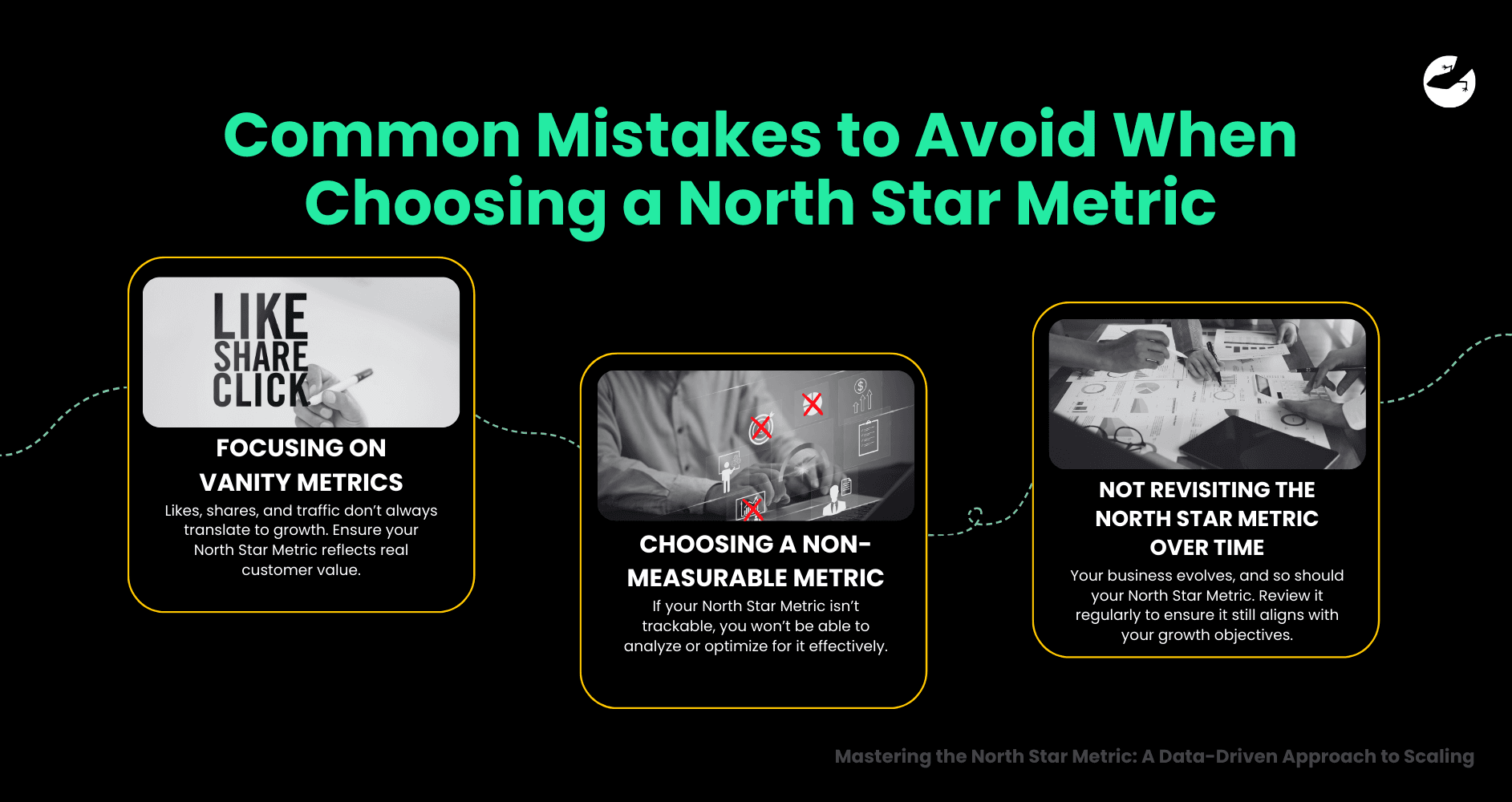
- Focusing on Vanity Metrics: Likes, shares, and traffic don’t always translate to growth. Ensure your North Star Metric reflects real customer value.
- Choosing a Non-Measurable Metric: If your North Star Metric isn’t trackable, you won’t be able to analyze or optimize for it effectively.
- Not Revisiting the North Star Metric Over Time: Your business evolves, and so should your North Star Metric. Review it regularly to ensure it still aligns with your growth objectives.
Lizard Global Can Help You Master Your North Star Metric
Choosing and optimizing the right North Star Metric can be the difference between chaotic scaling and structured, sustainable growth. But defining the right metric and implementing a data-driven strategy requires expertise.
At Lizard Global, we specialize in:
✅ Data-Driven Strategy Development – We help identify the best North Star Metric for your business. ✅ Custom Software & App Development – Ensuring your digital platforms support and enhance your North Star Metric. ✅ Growth Consulting & Analytics – Tracking, analyzing, and optimizing your North Star Metric with actionable insights.

Want to scale your business the smart way? Let’s talk! 🚀




